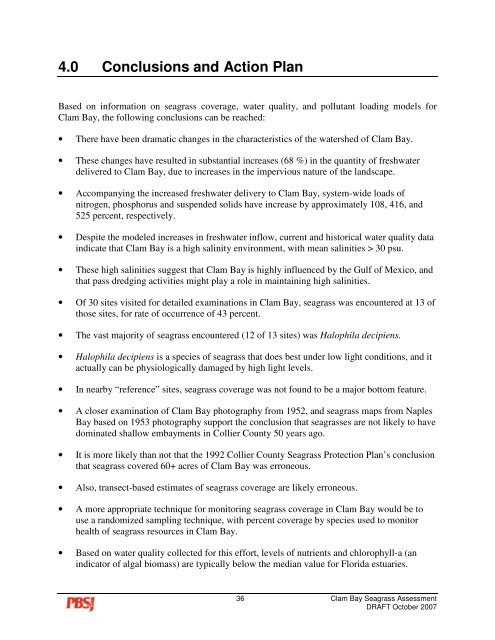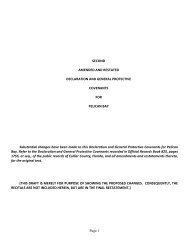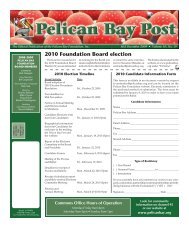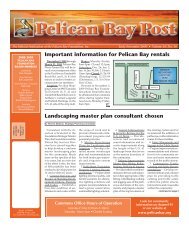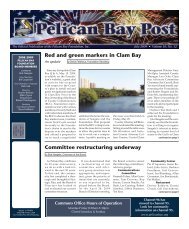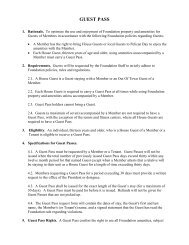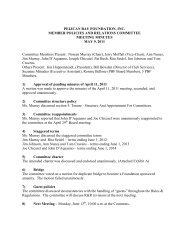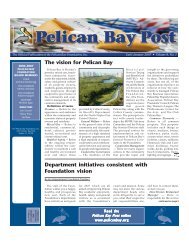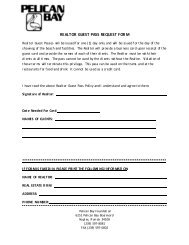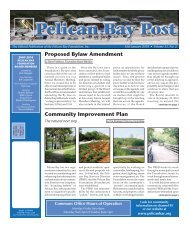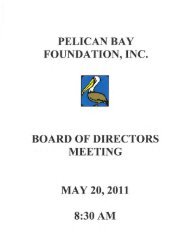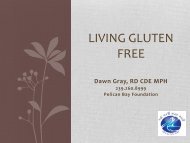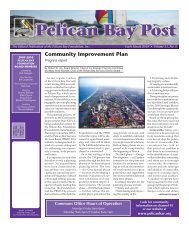Clam Bay Seagrass Assessment Collier County Coastal Zone ...
Clam Bay Seagrass Assessment Collier County Coastal Zone ...
Clam Bay Seagrass Assessment Collier County Coastal Zone ...
Create successful ePaper yourself
Turn your PDF publications into a flip-book with our unique Google optimized e-Paper software.
4.0 Conclusions and Action Plan<br />
Based on information on seagrass coverage, water quality, and pollutant loading models for<br />
<strong>Clam</strong> <strong>Bay</strong>, the following conclusions can be reached:<br />
• There have been dramatic changes in the characteristics of the watershed of <strong>Clam</strong> <strong>Bay</strong>.<br />
• These changes have resulted in substantial increases (68 %) in the quantity of freshwater<br />
delivered to <strong>Clam</strong> <strong>Bay</strong>, due to increases in the impervious nature of the landscape.<br />
• Accompanying the increased freshwater delivery to <strong>Clam</strong> <strong>Bay</strong>, system-wide loads of<br />
nitrogen, phosphorus and suspended solids have increase by approximately 108, 416, and<br />
525 percent, respectively.<br />
• Despite the modeled increases in freshwater inflow, current and historical water quality data<br />
indicate that <strong>Clam</strong> <strong>Bay</strong> is a high salinity environment, with mean salinities > 30 psu.<br />
• These high salinities suggest that <strong>Clam</strong> <strong>Bay</strong> is highly influenced by the Gulf of Mexico, and<br />
that pass dredging activities might play a role in maintaining high salinities.<br />
• Of 30 sites visited for detailed examinations in <strong>Clam</strong> <strong>Bay</strong>, seagrass was encountered at 13 of<br />
those sites, for rate of occurrence of 43 percent.<br />
• The vast majority of seagrass encountered (12 of 13 sites) was Halophila decipiens.<br />
• Halophila decipiens is a species of seagrass that does best under low light conditions, and it<br />
actually can be physiologically damaged by high light levels.<br />
• In nearby “reference” sites, seagrass coverage was not found to be a major bottom feature.<br />
• A closer examination of <strong>Clam</strong> <strong>Bay</strong> photography from 1952, and seagrass maps from Naples<br />
<strong>Bay</strong> based on 1953 photography support the conclusion that seagrasses are not likely to have<br />
dominated shallow embayments in <strong>Collier</strong> <strong>County</strong> 50 years ago.<br />
• It is more likely than not that the 1992 <strong>Collier</strong> <strong>County</strong> <strong>Seagrass</strong> Protection Plan’s conclusion<br />
that seagrass covered 60+ acres of <strong>Clam</strong> <strong>Bay</strong> was erroneous.<br />
• Also, transect-based estimates of seagrass coverage are likely erroneous.<br />
• A more appropriate technique for monitoring seagrass coverage in <strong>Clam</strong> <strong>Bay</strong> would be to<br />
use a randomized sampling technique, with percent coverage by species used to monitor<br />
health of seagrass resources in <strong>Clam</strong> <strong>Bay</strong>.<br />
• Based on water quality collected for this effort, levels of nutrients and chlorophyll-a (an<br />
indicator of algal biomass) are typically below the median value for Florida estuaries.<br />
36 <strong>Clam</strong> <strong>Bay</strong> <strong>Seagrass</strong> <strong>Assessment</strong><br />
DRAFT October 2007


